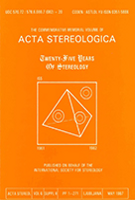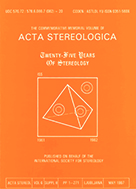- Accueil
- Volume 6 (1987)
- Supplement II (The commemorative-memorial volume: ...
- The importance of section thickness and particle diameter ratio in number per unit volume estimations evaluated by computer simulation (preliminary report)
Visualisation(s): 398 (2 ULiège)
Téléchargement(s): 16 (1 ULiège)
The importance of section thickness and particle diameter ratio in number per unit volume estimations evaluated by computer simulation (preliminary report)

Abstract
Computer simulation has been carried out on a model consisting of spheres of diameter D = 7 µm, randomly distributed in a cube with edge length 300 µm. The cube was systematically cut into slices of thickness t (0 μm ≤ t ≤ 20 μm). Four categories of stereological methods for estimating the number per unit volume for spheres were used : methods for true sections or for relatively thin sections (Wicksell, Weibel-Gomez, DeHoff, DeHoff's method modified by Weibel), methods for relatively thick sections (Abercrombie, Floderus), method for differential counting of particles (Ebbeson-Tang, Ebbeson-Tang's modified by Kališnik and Pajer) and methods for counting particles in three dimensional space (Sterio, Sterio's method modified by Howard et al.). For all methods under investigation the range of the ratio t/D where the relative deviation of the number per unit volume falls within acceptable limits of ± 10 % was established. The results show that three out of four methods for true or relatively thin sections lead, to acceptable results under the condition t/D ≤ 1/7. Among the methods for relatively thick sections the results approach acceptable values at ratios t/D > 2.5. Among the methods for differential counting of particles results are acceptable at ratios t1/D > 2.5, for the original method of Ebbeson-Tang. Ebbeson-Tang's modification by Kališnik and Pajer leads to acceptable results in all cases under investigation. The use of a disector in the original Sterio method highly underestimates the number per unit volume. Only the modification of Sterio’s method by Howard et al. leads to acceptable results at the ratio t/D > 3. It will be necessary to test the validity of the above findings on a model with higher resolution.





